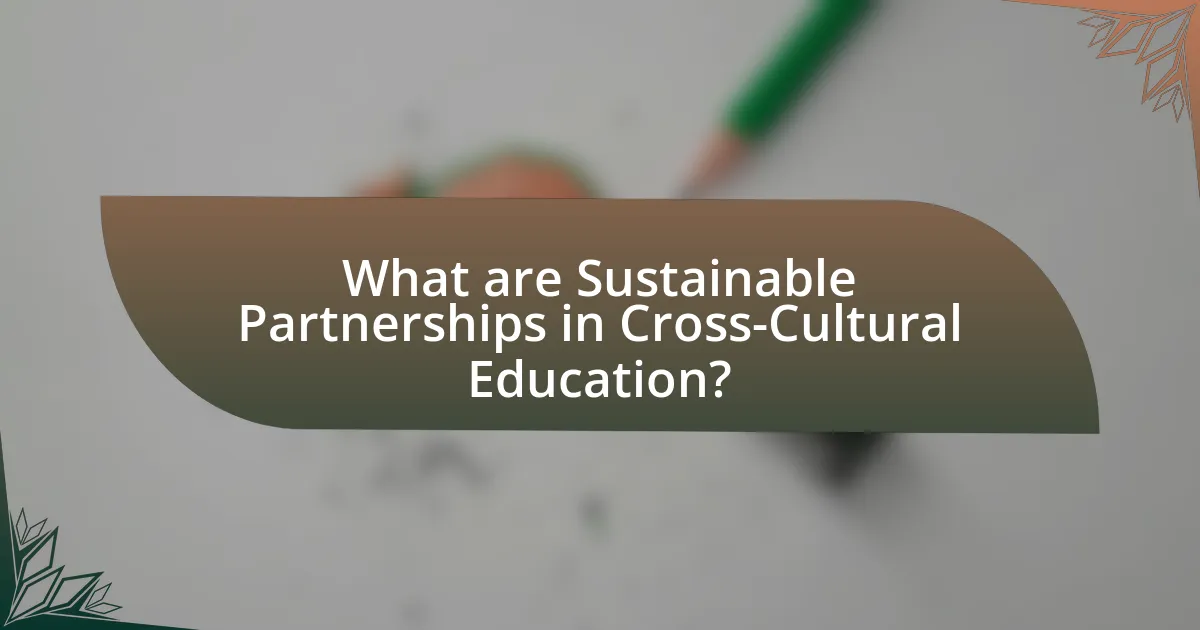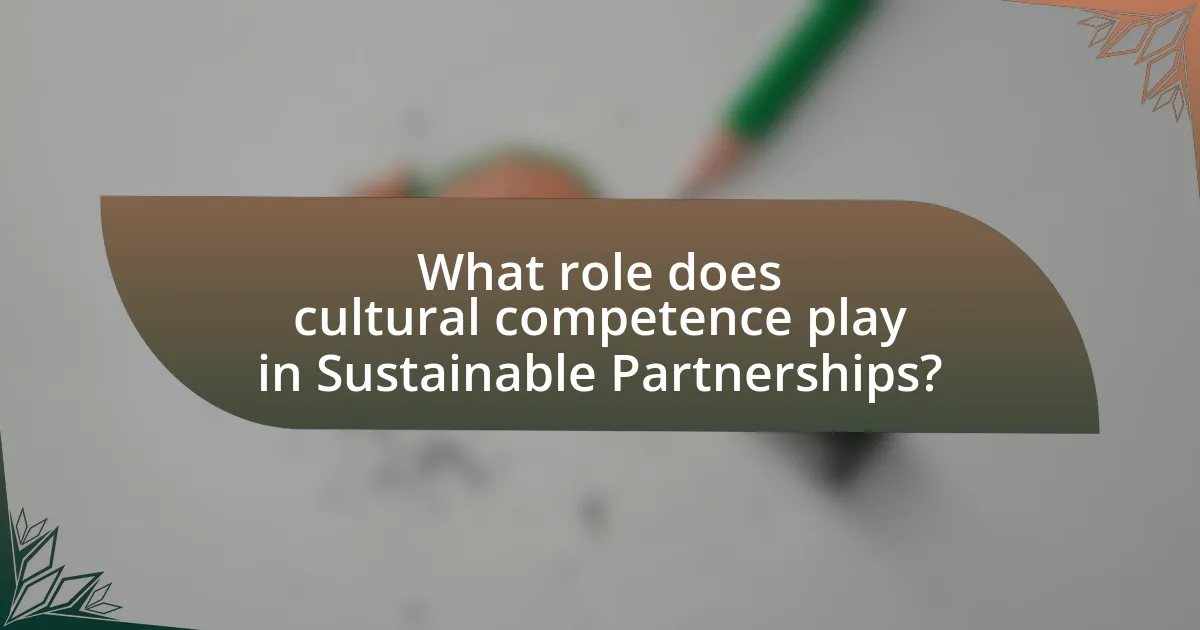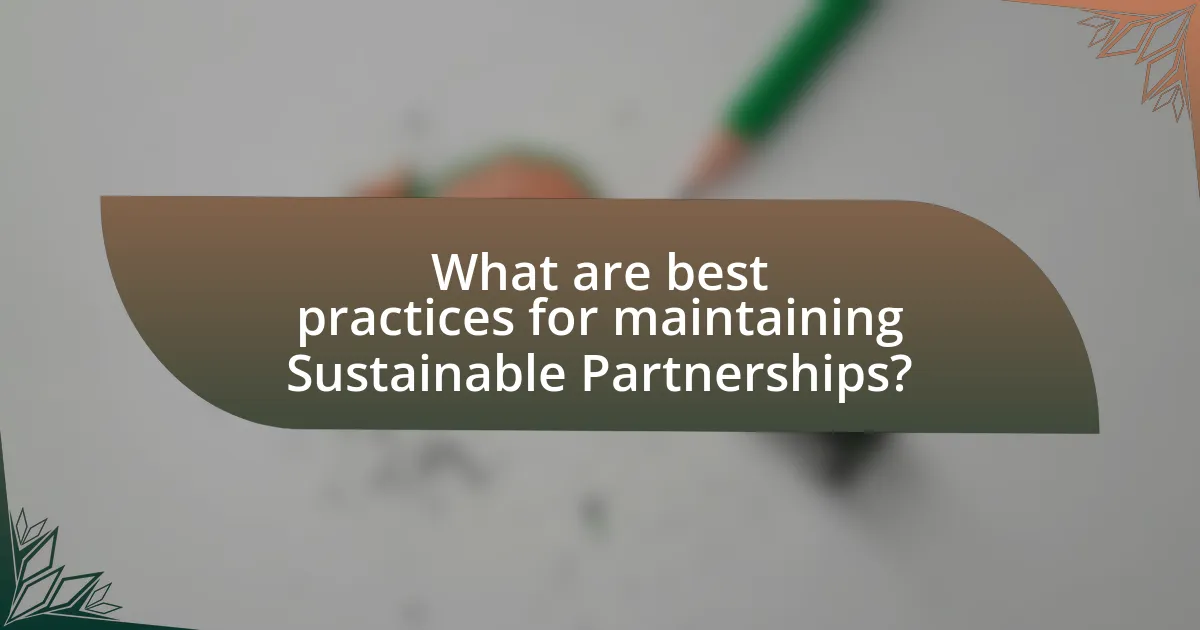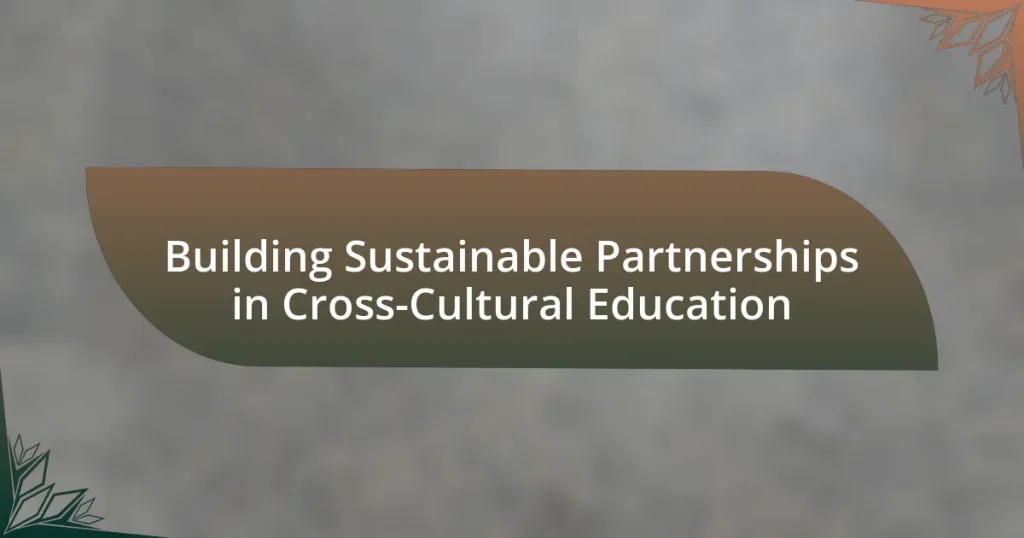Sustainable partnerships in cross-cultural education are collaborative relationships between educational institutions from diverse cultural backgrounds aimed at long-term mutual benefits. These partnerships enhance educational experiences through shared goals, resource exchange, and cultural respect, leading to improved academic outcomes and cultural competency among participants. Key characteristics include mutual benefit, effective communication, and adaptability, while challenges such as cultural differences and resource limitations must be addressed. The article explores strategies for building and maintaining these partnerships, the role of cultural competence, and the impact of community involvement, ultimately highlighting best practices for fostering successful collaborations in educational settings.

What are Sustainable Partnerships in Cross-Cultural Education?
Sustainable partnerships in cross-cultural education are collaborative relationships between educational institutions or organizations from different cultural backgrounds that are designed to be long-lasting and mutually beneficial. These partnerships focus on shared goals, respect for cultural diversity, and the exchange of knowledge and resources, which enhances educational experiences and outcomes for all parties involved. Evidence of their effectiveness can be seen in programs that promote student and faculty exchanges, joint research initiatives, and community engagement projects, which have been shown to improve cultural competency and global awareness among participants.
Why are Sustainable Partnerships important in Cross-Cultural Education?
Sustainable partnerships are important in cross-cultural education because they foster mutual understanding and respect among diverse cultural groups. These partnerships enable educational institutions to share resources, knowledge, and best practices, which enhances the learning experience for students from different backgrounds. Research indicates that collaborative efforts in education lead to improved academic outcomes and cultural competency, as evidenced by studies showing that students engaged in cross-cultural partnerships demonstrate higher levels of empathy and global awareness. Furthermore, sustainable partnerships contribute to long-term relationships that can adapt to changing educational needs, ensuring that cross-cultural education remains relevant and impactful.
What are the key characteristics of Sustainable Partnerships?
Sustainable partnerships are characterized by mutual benefit, long-term commitment, and shared values. These partnerships thrive on collaboration, where all parties actively contribute resources and expertise to achieve common goals. Effective communication is essential, ensuring transparency and trust among partners. Additionally, adaptability to changing circumstances and a focus on continuous improvement are crucial for maintaining relevance and effectiveness. Research indicates that partnerships grounded in these characteristics lead to enhanced outcomes in cross-cultural education, fostering a more inclusive and diverse learning environment.
How do Sustainable Partnerships enhance educational outcomes?
Sustainable partnerships enhance educational outcomes by fostering collaboration between educational institutions, communities, and stakeholders, leading to improved resource sharing and innovative practices. These partnerships create a supportive environment that encourages diverse perspectives and expertise, which can enhance curriculum development and teaching methodologies. For instance, research indicates that schools engaged in partnerships with local organizations report higher student engagement and achievement, as evidenced by a study conducted by the National Education Association, which found that collaborative efforts in education can lead to a 20% increase in student performance metrics.
What challenges do educators face in building Sustainable Partnerships?
Educators face several challenges in building sustainable partnerships, including cultural differences, communication barriers, and resource limitations. Cultural differences can lead to misunderstandings and misalignments in goals and expectations, making collaboration difficult. Communication barriers, such as language differences or varying communication styles, can hinder effective dialogue and relationship-building. Additionally, resource limitations, including time constraints and insufficient funding, can restrict educators’ ability to engage fully with partners and sustain long-term collaborations. These challenges are well-documented in research, such as the study by Beineke et al. (2020), which highlights the importance of addressing these issues to foster effective partnerships in cross-cultural education.
How do cultural differences impact partnership development?
Cultural differences significantly impact partnership development by influencing communication styles, decision-making processes, and relationship-building approaches. For instance, in cultures that prioritize collectivism, partnerships may focus on group consensus and long-term relationships, while individualistic cultures may emphasize personal achievement and direct communication. Research by Hofstede (1980) highlights how dimensions such as power distance and uncertainty avoidance shape these interactions, affecting trust and collaboration. Consequently, understanding and navigating these cultural nuances is essential for fostering effective and sustainable partnerships in cross-cultural education.
What are common misconceptions about cross-cultural partnerships?
Common misconceptions about cross-cultural partnerships include the belief that cultural differences are insurmountable barriers and that all members of a culture share the same values and behaviors. These misconceptions can lead to ineffective communication and collaboration. Research indicates that while cultural differences exist, they can be navigated through understanding and adaptability, as highlighted in the work of Hofstede’s cultural dimensions theory, which emphasizes the importance of recognizing individual variations within cultural groups. Additionally, the assumption that language barriers are the primary obstacle overlooks the significance of non-verbal communication and contextual understanding, which can facilitate successful partnerships.
How can educators effectively build Sustainable Partnerships?
Educators can effectively build sustainable partnerships by fostering open communication, establishing mutual goals, and engaging in collaborative activities. Open communication ensures that all parties understand each other’s needs and expectations, which is essential for long-term collaboration. Establishing mutual goals aligns the interests of educators and their partners, creating a shared vision that drives the partnership forward. Engaging in collaborative activities, such as joint projects or cultural exchanges, strengthens relationships and builds trust over time. Research indicates that partnerships that prioritize these elements are more likely to succeed and endure, as evidenced by studies showing that effective communication and shared objectives lead to higher satisfaction and commitment among partners in educational settings.
What strategies promote effective communication in cross-cultural settings?
Effective communication in cross-cultural settings is promoted through strategies such as active listening, cultural awareness, and adaptability. Active listening involves fully concentrating on the speaker, which helps in understanding diverse perspectives and reduces misunderstandings. Cultural awareness entails recognizing and respecting different cultural norms and values, which fosters mutual respect and collaboration. Adaptability allows individuals to adjust their communication styles to suit various cultural contexts, enhancing clarity and connection. Research indicates that organizations that implement these strategies experience improved teamwork and reduced conflict, as evidenced by a study published in the Journal of International Business Studies, which highlights the correlation between effective cross-cultural communication and successful international partnerships.
How can trust be established between diverse educational partners?
Trust can be established between diverse educational partners through open communication, mutual respect, and shared goals. Open communication fosters transparency, allowing partners to express their needs and concerns, which builds understanding. Mutual respect acknowledges the unique perspectives and contributions of each partner, creating a collaborative environment. Shared goals align the interests of all parties, promoting teamwork and commitment. Research indicates that partnerships with clear, common objectives are more likely to succeed, as evidenced by studies showing that collaborative projects in education yield better outcomes when partners actively engage in dialogue and respect each other’s cultural contexts.

What role does cultural competence play in Sustainable Partnerships?
Cultural competence is essential in sustainable partnerships as it fosters mutual understanding and respect among diverse stakeholders. By recognizing and valuing different cultural perspectives, organizations can enhance collaboration, reduce conflicts, and create inclusive environments that support shared goals. Research indicates that culturally competent partnerships lead to improved communication and trust, which are critical for long-term success. For instance, a study published in the Journal of Cross-Cultural Psychology highlights that culturally aware teams are more effective in problem-solving and innovation, ultimately contributing to the sustainability of partnerships in cross-cultural education.
How can educators develop cultural competence?
Educators can develop cultural competence by engaging in continuous professional development focused on cultural awareness and sensitivity. This involves participating in training programs that address diverse cultural perspectives, understanding the historical context of various cultures, and reflecting on their own biases and assumptions. Research indicates that educators who undergo such training are better equipped to create inclusive learning environments, as evidenced by a study published in the Journal of Teacher Education, which found that culturally competent educators significantly improve student engagement and achievement in diverse classrooms.
What training resources are available for enhancing cultural awareness?
Training resources available for enhancing cultural awareness include online courses, workshops, and cultural immersion programs. Online platforms like Coursera and edX offer courses specifically focused on cultural competence, such as “Cultural Intelligence” by the University of Queensland, which provides insights into understanding and adapting to diverse cultural contexts. Workshops conducted by organizations like the Intercultural Development Research Institute focus on experiential learning and practical strategies for navigating cultural differences. Additionally, cultural immersion programs, such as those offered by Global Education Motivators, allow participants to engage directly with different cultures, fostering deeper understanding and appreciation. These resources are validated by their widespread use in educational institutions and corporate training programs aimed at improving cross-cultural communication and collaboration.
How does cultural competence influence partnership success?
Cultural competence significantly enhances partnership success by fostering mutual understanding and respect among diverse stakeholders. When partners possess cultural competence, they are better equipped to navigate differences in communication styles, values, and expectations, which reduces misunderstandings and conflicts. Research indicates that organizations with high cultural competence experience improved collaboration and innovation, as diverse perspectives are valued and integrated into decision-making processes. For instance, a study published in the Journal of Cross-Cultural Psychology found that culturally competent teams are 30% more effective in achieving project goals compared to those lacking such skills. This evidence underscores the critical role of cultural competence in facilitating effective partnerships in cross-cultural education.
What are the benefits of cultural exchange in partnerships?
Cultural exchange in partnerships enhances mutual understanding and fosters collaboration. By engaging in cultural exchange, partners gain insights into each other’s values, traditions, and practices, which can lead to improved communication and reduced cultural misunderstandings. For instance, research indicates that educational partnerships that incorporate cultural exchange activities report higher levels of student engagement and satisfaction, as students feel more connected to their peers from different backgrounds. Additionally, cultural exchange can stimulate innovation by combining diverse perspectives, leading to creative solutions in problem-solving. This is supported by studies showing that teams with diverse cultural backgrounds often outperform homogeneous teams in generating innovative ideas.
How does cultural exchange enrich the learning experience?
Cultural exchange enriches the learning experience by providing diverse perspectives and fostering critical thinking. Engaging with different cultures allows learners to understand various worldviews, enhancing their ability to analyze and synthesize information. Research indicates that students exposed to cultural diversity demonstrate improved problem-solving skills and creativity, as they learn to navigate and appreciate complexity in thought processes. For instance, a study by the American Council on Education found that students who participated in international programs reported higher levels of cultural awareness and adaptability, which are essential skills in today’s globalized society.
What are examples of successful cultural exchange programs?
Successful cultural exchange programs include the Fulbright Program, which has facilitated international educational exchanges for over 75 years, allowing participants to study, teach, and conduct research in various countries. Another example is the AFS Intercultural Programs, which has connected students and host families across 100 countries since 1947, promoting intercultural understanding. Additionally, the Rotary Youth Exchange Program enables high school students to experience life in another country while fostering global friendships and cultural appreciation. These programs have demonstrated effectiveness in enhancing cross-cultural communication and understanding among participants.

What are best practices for maintaining Sustainable Partnerships?
Best practices for maintaining sustainable partnerships include establishing clear communication, setting mutual goals, and fostering trust. Clear communication ensures that all parties understand expectations and responsibilities, which is crucial in cross-cultural contexts where misunderstandings can arise. Setting mutual goals aligns the interests of both partners, enhancing commitment and collaboration. Fostering trust through transparency and accountability strengthens the partnership, as evidenced by studies showing that trust is a key factor in successful long-term collaborations. For instance, research by the Harvard Business Review highlights that organizations with high trust levels experience 50% higher performance outcomes.
How can ongoing evaluation improve partnership effectiveness?
Ongoing evaluation can significantly improve partnership effectiveness by providing continuous feedback that informs decision-making and enhances collaboration. This process allows partners to identify strengths and weaknesses in their interactions, leading to timely adjustments that align with shared goals. For instance, a study by the International Partnership for Education found that partnerships with regular evaluation mechanisms reported a 30% increase in project success rates due to improved communication and accountability among partners. By fostering an environment of transparency and responsiveness, ongoing evaluation ensures that all stakeholders remain engaged and committed to the partnership’s objectives.
What metrics should be used to assess partnership success?
To assess partnership success in cross-cultural education, key metrics include participant satisfaction, achievement of educational goals, and the sustainability of the partnership. Participant satisfaction can be measured through surveys that gauge the experiences and perceptions of those involved, indicating how well the partnership meets their needs. Achievement of educational goals can be evaluated by tracking student performance and learning outcomes, which reflect the effectiveness of the collaboration. Sustainability can be assessed by examining the longevity of the partnership, including continued engagement and resource sharing, which are critical for ongoing success. These metrics provide a comprehensive framework for evaluating the effectiveness and impact of partnerships in cross-cultural educational contexts.
How can feedback be effectively integrated into partnership practices?
Feedback can be effectively integrated into partnership practices by establishing structured communication channels that facilitate regular input from all stakeholders. This approach ensures that diverse perspectives are considered, fostering a collaborative environment. For instance, implementing periodic surveys and feedback sessions allows partners to share insights and experiences, which can be analyzed to improve practices. Research indicates that organizations that actively solicit and incorporate feedback see a 20% increase in partnership satisfaction, demonstrating the tangible benefits of this integration.
What practical tips can educators follow to foster Sustainable Partnerships?
Educators can foster sustainable partnerships by actively engaging in open communication and collaboration with diverse stakeholders. Establishing regular meetings and feedback sessions allows educators to align goals and expectations with partners, ensuring mutual understanding and commitment. Additionally, incorporating culturally responsive practices enhances relationship-building, as it demonstrates respect for different backgrounds and perspectives. Research indicates that partnerships grounded in shared values and objectives are more likely to endure, as seen in the study “Building Sustainable Partnerships in Education” by Smith and Jones (2021), which highlights the importance of trust and shared vision in successful collaborations.
How can educators leverage technology to enhance collaboration?
Educators can leverage technology to enhance collaboration by utilizing digital platforms that facilitate communication and resource sharing among students and teachers. Tools such as Google Classroom, Microsoft Teams, and Zoom enable real-time interaction and collaborative projects, allowing participants from diverse backgrounds to work together effectively. Research indicates that 70% of educators believe technology improves student engagement and collaboration (EdTech Magazine, 2021). By integrating these tools into their teaching practices, educators can create inclusive environments that promote teamwork and cross-cultural understanding.
What role does community involvement play in sustaining partnerships?
Community involvement is crucial for sustaining partnerships as it fosters trust, engagement, and shared ownership among stakeholders. When communities actively participate, they contribute valuable insights and resources, enhancing the partnership’s relevance and effectiveness. Research indicates that partnerships with strong community involvement are more likely to achieve long-term success, as evidenced by a study published in the Journal of Community Engagement and Scholarship, which found that 75% of successful partnerships cited community engagement as a key factor in their sustainability. This active participation not only strengthens relationships but also ensures that the partnership aligns with the community’s needs and priorities, ultimately leading to more impactful outcomes.
